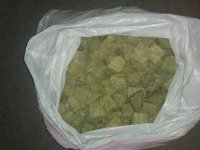captinahab
Member
From my notebook (someone elses words)
"In organic soil (aka living soil) you also do not adjust the ph. The microbes control the ph and the plant controls the microbs. CAC(cation exchange capacity)... humic substances and clay will hold calcium ions wherr they can be exchanged with other cautions for uptake by the roots.
Thats how humic substances and clay play the role they do in maintning the p.h. (to many free ions without a home to land on).
Trying to amend ones way to successful gardening is basicaly an attempt to appy the concepts of hydoponics to soil.
Pointless as usual "
So it looks like soil people dont p.h. either...i really do not see the need for p.h. meters at all.... but i still am curious what your ppm is with your normal base food without ph adjustment?
I would play with it... and more base or water till the solution reads a ph of what you want(although plants will change the p.h. to their own liking). Good chance if the p.h. is good then its a ballanced drink for the girls... hey i guess i do have a use for ph meters after all.
"In organic soil (aka living soil) you also do not adjust the ph. The microbes control the ph and the plant controls the microbs. CAC(cation exchange capacity)... humic substances and clay will hold calcium ions wherr they can be exchanged with other cautions for uptake by the roots.
Thats how humic substances and clay play the role they do in maintning the p.h. (to many free ions without a home to land on).
Trying to amend ones way to successful gardening is basicaly an attempt to appy the concepts of hydoponics to soil.
Pointless as usual "
So it looks like soil people dont p.h. either...i really do not see the need for p.h. meters at all.... but i still am curious what your ppm is with your normal base food without ph adjustment?
I would play with it... and more base or water till the solution reads a ph of what you want(although plants will change the p.h. to their own liking). Good chance if the p.h. is good then its a ballanced drink for the girls... hey i guess i do have a use for ph meters after all.

 my last grow was my 20 year aniv of growing. As a middle finger up... wave that flag high and proud... i did a tribute grow of albfuct (from auzzie land) high plant count sog.
my last grow was my 20 year aniv of growing. As a middle finger up... wave that flag high and proud... i did a tribute grow of albfuct (from auzzie land) high plant count sog.

